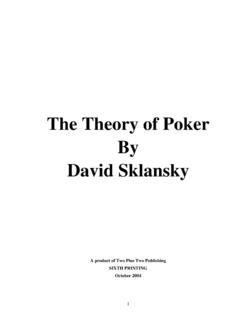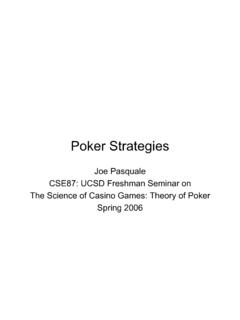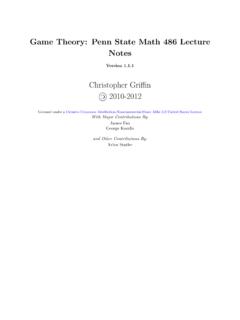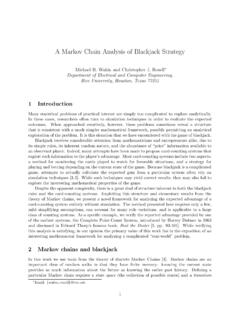Transcription of Approximating Game-Theoretic Optimal Strategies for Full ...
1 Approximating Game-Theoretic Optimal Strategies for Full-scale Poker D. Billings, N. Burch, A. Davidson, R. Holte, J. Schaeffer, T. Schauenberg, and D. Szafron Department of Computing Science, University of Alberta Edmonton, Alberta, T6G 2E8, Canada Email: darse,burch,davidson,holte,jonathan,tere nce,duane Abstract Due to the computational limitations involved, only simpli- fied poker variations have been solved in the past ( [Kuhn, The computation of the first complete approxima- 1950; Sakaguchi and Sakai, 1992 ]). While these are of the- tions of Game-Theoretic Optimal Strategies for full- oretical interest, the same methods are not feasible for real scale poker is addressed. Several abstraction tech- games , which are too large by many orders of magnitude niques are combined to represent the game of 2- player Texas Hold'em, having size . , using ([Koller and Pfeffer, 1997 ]). [Shi and Littman, 2001 ] investigated abstraction tech- closely related models each having size.
2 Niques to reduce the large search space and complexity of the Despite the reduction in size by a factor of 100 problem, using a simplified variant of poker. [Takusagawa, billion, the resulting models retain the key prop- 2000] created near- Optimal Strategies for the play of three erties and structure of the real game. Linear pro- specific Hold'em flops and betting sequences. [Selby, 1999]. gramming solutions to the abstracted game are used computed an Optimal solution for the abbreviated game of to create substantially improved poker-playing pro- preflop Hold'em. grams, able to defeat strong human players and be Using new abstraction techniques, we have produced vi- competitive against world-class opponents. able pseudo- Optimal Strategies for the game of 2-player Texas Hold'em. The resulting poker-playing programs have 1 Introduction demonstrated a tremendous improvement in performance. Mathematical game theory was introduced by John von Neu- Whereas the previous best poker programs were easily beaten mann in the 1940s, and has since become one of the founda- by any competent human player, the new programs are capa- tions of modern economics [von Neumann and Morgenstern, ble of defeating very strong players, and can hold their own 1944].
3 Von Neumann used the game of poker as a basic against world-class opposition. model for 2-player zero-sum adversarial games , and proved Although some domain-specific knowledge is an asset in the first fundamental result, the famous minimax theorem. A creating accurate reduced-scale models, analogous methods . few years later, John Nash added results for -player non- can be developed for many other imperfect information do- mains and generalized game trees. We describe a general cooperative games , for which he later won the Nobel Prize [Nash, 1950 ]. Many decision problems can be modeled using method of problem reformulation that permits the indepen- game theory , and it has been employed in a wide variety of dent solution of sub-trees by estimating the conditional prob- domains in recent years. abilities needed as input for each computation. Of particular interest is the existence of Optimal solutions, This paper makes the following contributions: or Nash equilibria.
4 An Optimal solution provides a random- 1. Abstraction techniques that can reduce an ized mixed strategy, basically a recipe of how to play in each poker search space to a manageable , without possible situation. Using this strategy ensures that an agent losing the most important properties of the game. will obtain at least the Game-Theoretic value of the game, re- gardless of the opponent's strategy. Unfortunately, finding 2. A poker-playing program that is a major improvement exact Optimal solutions is limited to relatively small problem over previous efforts, and is capable of competing with sizes, and is not practical for most real domains. world-class opposition. This paper explores the use of highly abstracted mathemat- ical models which capture the most essential properties of the 2 Game theory real domain, such that an exact solution to the smaller prob- Game theory encompasses all forms of competition between lem provides a useful approximation of an Optimal strategy two or more agents.
5 Unlike chess or checkers, poker is a for the real domain. The application domain used is the game game of imperfect information and chance outcomes. It can of poker, specifically Texas Hold'em, the most popular form be represented with an imperfect information game tree hav- of casino poker and the poker variant used to determine the ing chance nodes and decision nodes, which are grouped into world champion at the annual World Series of Poker. information sets. Since the nodes in this tree are not independent, divide- and-conquer methods for computing sub-trees (such as the alpha-beta algorithm) are not applicable. For a more detailed description of imperfect information game tree structure, see [Koller and Megiddo, 1992 ]. A strategy is a set of rules for choosing an action at ev- ery decision node of the tree. In general, this will be a ran- domized mixed strategy, which is a probability distribution over the various alternatives.
6 A player must use the same pol- icy across all nodes in the same information set, since from that player's perspective they are indistinguishable from each other (differing only in the hidden information component). The conventional method for solving such a problem is to convert the descriptive representation, or extensive form, into a system of linear equations, which is then solved by a lin- ear programming (LP) system such as the Simplex algorithm. The Optimal solutions are computed simultaneously for all players, ensuring the best worst-case outcome for each player. Figure 1: Branching factors for Hold'em and abstractions. Traditionally, the conversion to normal form was accom- panied by an exponential blow-up in the size of the prob- lem, meaning that only very small problem instances could 4 Abstractions be solved in practice. [Koller et al., 1994] described an alter- Texas Hold'em has an easily identifiable structure, alternat- nate LP representation, called sequence form, which exploits ing between chance nodes and betting rounds in four distinct the common property of perfect recall (wherein all players stages.)
7 A high-level view of the imperfect information game know the preceding history of the game), to obtain a system tree is shown in Figure 1. of equations and unknowns that is only linear in the size of Hold'em can be reformulated to produce similar but much the game tree. This exponential reduction in representation smaller games . The objective is to reduce the scale of the has re-opened the possibility of using Game-Theoretic analy- problem without severely altering the fundamental structure sis for many domains. However, since the game tree itself of the game, or the resulting Optimal Strategies . There are can be very large, the LP solution method is still limited to many ways of doing this, varying in the overall reduction and moderate problem sizes (normally less than a billion nodes). in the accuracy of the resulting approximation. Some of the most accurate abstractions include suit equiv- alence isomorphisms (offering a reduction of at most a factor 3 Texas Hold'em of ), rank equivalence (only under certain conditions), A game (or hand) of Texas Hold'em consists of four stages, and rank near-equivalence.
8 The Optimal solutions to these ab- each followed by a round of betting: stracted problems will either be exactly the same or will have Preflop: Each player is dealt two private cards face down a small bounded error, which we refer to as near- Optimal so- (the hole cards). lutions. Unfortunately, the abstractions which produce an ex- Flop: Three community cards (shared by all players) are act or near-exact reformulation do not produce the very large dealt face up. reductions required to make full-scale poker tractable. Turn: A single community card is dealt face up. A common method for controlling the game size is deck River: A final community card is dealt face up. reduction. Using less than the standard 52-card deck greatly reduces the branching factor at chance nodes. Other methods After the betting, all active players reveal their hole cards include reducing the number of cards in a player's hand ( for the showdown.)
9 The player with the best five-card poker from a 2-card hand to a 1-card hand), and reducing the num- hand formed from their two private cards and the five public ber of board cards ( a 1-card flop), as was done by [Shi cards wins all the money wagered (ties are possible). and Littman, 2001] for the game of Rhode Island Hold'em. The game starts off with two forced bets (the blinds) put [Koller and Pfeffer, 1997 ] used such parameters to generate a into the pot. When it is a player's turn to act, they must ei- wide variety of tractable games to solve with their Gala sys- ther bet/raise (increase their investment in the pot), check/call tem. (match what the opponent has bet or raised), or fold (quit and We have used a number of small and intermediate sized surrender all money contributed to the pot). games , ranging from eight cards (two suits, four ranks) to 24. The best-known non-commercial Texas Hold'em program cards (three suits, eight ranks) for the purpose of studying is Poki.
10 It has been playing online since 1997 and has earned abstraction methods, comparing the results with known exact an impressive winning record, albeit against generally weak or near- Optimal solutions. However, these smaller games are opposition [Billings et al., 2002 ]. The system's abilities not suitable for use as an approximation for Texas Hold'em, are based on enumeration and simulation techniques, expert as the underlying structures of the games are different. To knowledge, and opponent modeling. The program's weak- produce good playing Strategies for full-scale poker, we look nesses are easily exploited by strong players, especially in for abstractions of the real game which do not alter that basic the 2-player game. structure. The effect of truncation can be lessened through the use The abstraction techniques used in practice are powerful of expected value leaf nodes. Instead of ending the game in terms of reducing the problem size, and subsume those abruptly and awarding the pot to the strongest hand at that previously mentioned.










